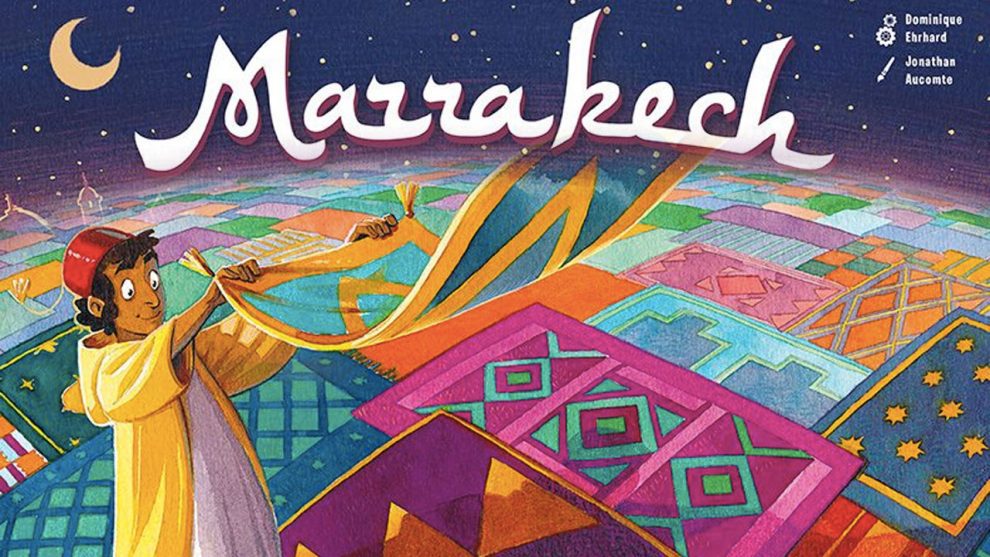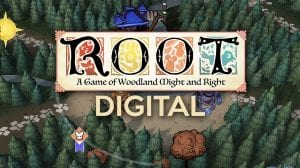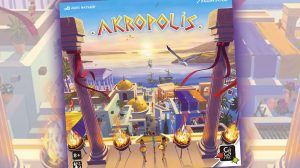Disclosure: Meeple Mountain received a free copy of this product in exchange for an honest, unbiased review. This review is not intended to be an endorsement.
Welcome to Marrakech, one of the largest cities in all of Morocco! Here you will compete with your fellow merchants to display your carpets and amass Dirhams to be heralded as the greatest carpet merchant in the city.
Or something like that.

In Marrakech, from Gigamic, you’ll be displaying placing your carpets on the board on each turn, hoping your opponents will land on them. When they do, you’ll be paid in Dirhams (coins), which also represent end-game points.
Let’s get the game to the table and see how it plays.
Find Out Why
Each player starts by collecting all the carpets of their chosen color/pattern from the four available types.
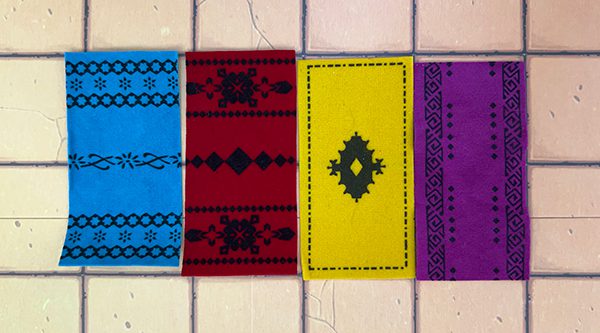
Lay out the board within easy reach of all players, then set Assam in the center square. Give each player 30 Dirhams (coins).

Select a starting player and give them the big, chunky six-sided die.
Now you’re ready to play.
How it Should Be
On a turn, you’ll start by deciding whether or not you want to turn Assam 90º to the right or left. (Assam can never turn 180º and go back the way he came.) Then you’ll roll the die and move Assam that many spaces.
If you move off the edge of the board, follow the curved entryway that leads you back onto the board.
After moving Assam, you must lay out one of your carpets.

Carpets can be laid along any of the eight squares surrounding Assam. Additionally, they can be laid in a straight line ahead, behind, or to the right or left.
Placing carpets is key to how you win the game. This occurs in two ways:
- Any time a player moves Assam onto one of your carpets, you add up how many squares of your carpets are orthogonally connected. (Since each carpet takes up two squares, solid carpets are counted as two squares.) The player who moved Assam must then pay the owner of those carpets that many Dirham. You’ll score one point per Dirham at the end of the game.
- You’ll also score one point per square of exposed carpet at the end of the game.
When placing a carpet you can never place it so it completely covers another carpet in one go. Covering half of a carpet is fine, as is covering two halves of carpets belonging to two of your opponents.
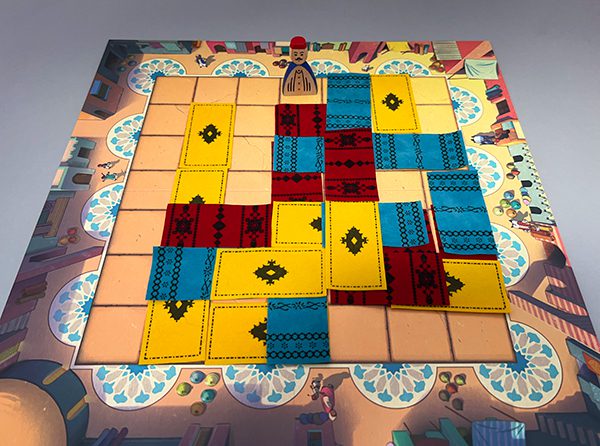
Play continues clockwise around the table with players moving Assam, paying their opponents (if necessary), and adding a carpet to the board until all carpets have been placed.
Two Worlds Collide
A quick word on the components, because they really do help make the game that much more enjoyable.
The carpets are felt, a soft material that remains relatively stiff for easy placement on the board. The colors and, more importantly for colorblind players, the patterns are each very distinct. By the end of the game, you will have created a hodge-podge maze of carpets that is both unique and pleasing to the eye. My gaming group has commented on how much they like these carpets each time we’ve played Marrakech.
Assam and the die are both wooden. Assam is a tad stereotyped, but the red fez (I’m sorry, fezes, much like bowties, are never cool) is authentic. If the die looks oversized in my photo that’s because it is. The edges and corners of the die are rounded, so the die can easily spin like a top if you roll it just right. (This helped with my general aversion to games with six-sided dice.)
Gigamic could have easily gone with cheaper components, so I appreciate the extra steps they took to elevate these important aspects of the game.
This is How it Feels

If you think Marrakech has an abstract game feel to it, you’re right. The theme feels fairly loose, although it does work. Add in a six-sided die for a variety of movements and the wandering Assam, and you have yourself a game.
It’s also fair to say that the game takes a while to get interesting. The 7×7 board feels a bit too big. For the first half of the game players are able to position Assam at the start of their turns to easily avoid anyone’s carpets.
About halfway through the game, as carpets are covering the majority of the squares on the board, turns become a bit more tense. You and/or your opponents will each have orthogonal runs of carpet zig-zagging sections of the board that others will want to avoid.
As well, it’s common to find sections of the board that are being contested, with carpets three-to-six layers deep.
The thing to remember here, though, is that you’re still going to score points for all of your exposed carpets at the end of the game. Fighting over those areas can mean potentially wasted end-game points. Laying down carpets where people aren’t going may not score you lots of Dirham, but it will still score you points.
Marrakech is best at 3-4 players. In the two-player variant, the rules call for each player taking on two types of carpet. It’s a necessary rule—otherwise, the board is really too big. Keeping track of two different rugs makes the game a bit more challenging, but I found I preferred the 3-player game much more.
My group and I have been surprised by how much we’ve enjoyed Marrakech. It’s a simple game to teach and, at three players, plays in under 20 minutes. It makes for a good filler game after a long session of something crunchy and deep. There’s just enough strategy to make the game interesting, while the die rolls mean you’re surrendering the game to the whims of randomness.
Like Cascadia, the word we’ve used to describe Marrakech has been “relaxing.” If you’re looking for a nice filler or a game to play with the family, I recommend you give Marrakech a try.
All on Board the Train
And, yes, I know what you’ve been thinking this entire time: ‘Tom, why didn’t you go with the obvious Crosby, Stills, and Nash’s Marrakesh Express lyrics for the headers?.’ It’s because they spelled the city with an “sh” at the end instead of the “ch” Gigamic went with.
But Wait…There’s More!
How many board games do you know that have been featured in anime?


